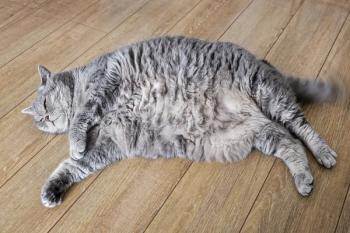
- dvm360 September 2024
- Volume 55
- Issue 9
- Pages: 28
Identifying and treating canine and feline urolithiasis
Management of the condition includes postoperative therapy and follow-up care
Urolithiasis is a common complaint in dogs and cats presented to veterinary emergency, primary care, and specialty services. Although uroliths can appear anywhere along the urinary tract, the bladder is the most common location.1
Uroliths can be identified incidentally because of a workup of urinary signs, or a life-threatening urinary obstruction. Prompt diagnosis and intervention are important to maximize the likelihood of a successful outcome.
Diagnosis
Many patients with urolithiasis present for lower urinary tract signs such as hematuria, stranguria, and pollakiuria. In cases of a urinary obstruction, they may present with a history of straining to urinate without production, vomiting, and anorexia. Although diagnostic imaging is the ideal method of diagnosis for urolithiasis, other diagnostics should not be overlooked.
Uroliths are broadly categorized as radiolucent or radiopaque, although in clinical practice there is more of a spectrum than a binary classification. Historically, urate crystals and cystine calculi are classified as radiolucent, and other stone types (eg, calcium oxalate, struvite, silica, and brushite) are classified as radiopaque.
Following confirmation of the presence of cystic calculi, it is essential to perform additional diagnostics to identify any concurrent conditions that may contribute to stone formation and recurrence. Such additional diagnostics include a biochemistry panel to evaluate for hypercalcemia, a known risk factor for calcium oxalate formation, or changes in synthetic liver enzymes that may signal liver pathology or presence of a portosystemic shunt that can drive urate stone formation. A urinalysis should also be performed to screen for bacteriuria or pyuria as well as to measure pH in the event that alkalinization or acidification of the urine is necessary following a determination of stone type to minimize the chances of recurrence.
Treatment options
Depending on the size and number of calculi, as well as the size and species of the patient, various treatment options may be available such as voiding urohydropulsion, cystoscopic retrieval, or surgical options such as a cystotomy or percutaneous cystolithotomy. It is important to note that the only stone type amenable to dissolution is struvite.
Cystotomy
A caudal celiotomy is performed, and the bladder is isolated and exteriorized. A stay suture is placed in the bladder apex using 3-0 or 4-0 monofilament, as appropriate. A stab incision is made into the ventral aspect of the bladder, and the incision extended with Metzenbaum scissors. A bladder spoon may be used to remove the calculi in the bladder. A red rubber catheter of appropriate size should be passed retrograde and used to flush any remnant urethral calculi into the bladder for removal. Surgery should not be considered complete until all residual calculi have been removed via the cystotomy. A small sample of bladder mucosa should be obtained and submitted for culture. Closure of the bladder may proceed in a simple interrupted or continuous pattern, using a 3-0 or 4-0 monofilament suture. The bladder heals very quickly, reaching normal tissue strength in 14 to 21 days, so a quickly absorbable monofilament such as Monocryl or Biosyn is recommended for closure. A leak test is at the discretion of the surgeon but is strongly recommended for novice surgeons. This may be done either via the urinary catheter or by injecting sterile saline directly into the bladder with a syringe and needle.
Percutaneous cystolithotomy
This is a newer technique used to remove cystic calculi as well as obtain bladder biopsies in a minimally invasive fashion. This technique requires some additional instrumentation such as an Alexis wound retractor, a pediatric cystoscope or flexible ureteroscope, laparoscopic ports, and ideally a stone extraction basket. The advantages of this technique include fewer long-term stone recurrences, a lower likelihood of incomplete removal of uroliths, and shorter hospitalization times in addition to the traditional advantages of minimally invasive surgery, such as decreased pain and a quicker recovery.2-4
For this technique, an approximately 2-cm ventral midline incision is made following placement of a large urinary catheter, and an Alexis wound retractor is placed to provide radial retraction. A stay suture is placed in the apex of the bladder, and then 2 additional stay sutures are placed, forming a triangle. A stab incision is made in the center of the triangle using an No. 11 blade, and a 5-mm laparoscopic point is inserted into the cystotomy. At this point, the endoscope can be introduced and fluids connected to the urinary catheter. Calculi will generally accumulate toward the trigone and can be visualized with the endoscope (Figure 1). Small stones can be flushed through the laparoscopic port and collected, but larger ones will need to be manipulated with the stone extractor basket to be removed.
Tips and tricks
One challenging aspect of performing a cystotomy to remove calculi is maintaining visualization. In conjunction with this, urothelium is a sensitive tissue and quickly becomes edematous with manipulation. The creative use of stay sutures can facilitate visualization and decrease frustration with the procedure. When performing a cystotomy, the placement of not only the stay suture at the apex but also one on either side of the cystotomy can aid in visualization of the trigone and proximal urethra (Figure 2).
An additional challenging element during a cystotomy may be the retrograde placement of a urinary catheter in a female dog or cat. One method to tackle this is to first pass a urinary catheter normograde until it exits the urethra and then suture a second urinary catheter of the same or a smaller size to the first. The original urinary catheter may now be pulled backward, which will facilitate placement of the retrograde urinary catheter. Another method to tackle this problem is the 2-catheter technique for urethral catheterization described by Dornbusch et al.5 This is a technique in which a large urinary catheter is placed somewhat dorsal to block off the vagina. A second, more appropriately placed urinary catheter is then inserted and is unable to be deflected into the vagina and will thus enter the urethra.
Postoperative management
Following a routine cystotomy, an unobstructed patient is ideally maintained on isotonic crystalloids at a maintenance rate as well as analgesia such as a pure μ-opioid. Methadone (0.1-0.2 mg/kg intravenously every 6 to 8 hours) is a common choice following cystotomy. An indwelling urinary catheter is not necessary in the postoperative period. Most patients can be discharged the following day and are managed on routine oral medications such as gabapentin (10 mg/ kg orally every 8 hours) or codeine (1-2 mg/ kg orally every 8 to 12 hours). Nonsteroidal anti-inflammatory drugs should be avoided if the patient presented with an obstruction, and postoperative blood gases should be monitored in this case to ensure appropriate correction of potential electrolyte derangements and azotemia.
Readers are directed to more specific texts for management of urinary obstructions. The decision to prescribe postoperative antimicrobials should be made based on preoperative diagnostics and the likelihood of a concurrent urinary tract infection or concern for a break in sterility.
Follow-up
Stones collected should be sent to a reference lab for identification to tailor follow-up care and minimize chances of recurrence. Identification of any comorbidities should also prompt the clinician to recommend treatment and may alter postoperative management of the patient with urolithiasis. Depending on the type of stone that is identified, follow-up recommendations may include acidifying or alkalinizing the urine, castration, dietary changes, or regular diagnostics such as radiographs and urinalyses.
References
- Johnston SA, Tobias KM, eds. Veterinary Surgery: Small Animal Expert Consult. 3rd ed. Saunders; 2017.
- Cruciani B, Vachon C, Dunn M. Removal of lower urinary tract stones by percutaneous cystolithotomy: 68 cases (2012-2017). Vet Surg. 2020;49(suppl 1):138-147. doi: 10.1111/ vsu.13398
- Runge JJ, Berent AC, Mayhew PD, Weisse C. Transvesicular percutaneous cystolithotomy for the retrieval of cystic and urethral calculi in dogs and cats: 27 cases (2006-2008). J Am Vet Med Assoc. 2011;239(3):344-349. doi:10.2460/ javma.239.3.344
- Grant DC, Harper TAM, Werre SR. Frequency of incomplete urolith removal, complications, and diagnostic imaging following cystotomy for removal of uroliths from the lower urinary tract in dogs: 128 cases (1994-2006). J Am Vet Med Assoc. 2010;236(7):763-766. doi:10.2460/javma.236.7.763
- Dornbusch JA, Yaxley PE, Hechler AC, Bryon JK, Selmic LE. A novel two-catheter method for urethral catheterization improves success rates of urethral catheterization in female dogs and cats weighing less than ten kilograms. J Am Vet Med Assoc. 2023;261(11):1623-1627. doi:10.2460/ javma.23.04.0209
Articles in this issue
about 1 year ago
What’s in a name?about 1 year ago
Clearing the air in contaminated spacesabout 1 year ago
Compassionate conversations when scheduling euthanasiaabout 1 year ago
How to create an attendance policyabout 1 year ago
Dentistry A to Z: G is for geneticsabout 1 year ago
The amazing POTUS — pets of the United States!about 1 year ago
Hands-on labs aim to build skills for Fetch Coastal attendeesabout 1 year ago
Peticaid: An idea whose time has comeabout 1 year ago
Surgical management of advanced mammary disease in ruminantsNewsletter
From exam room tips to practice management insights, get trusted veterinary news delivered straight to your inbox—subscribe to dvm360.






